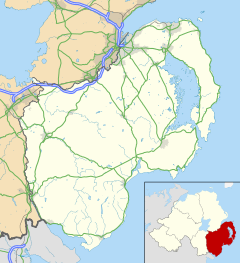Rathfriland
Rathfriland
|
|
|---|---|
 |
|
| Rathfriland shown within County Down | |
| Population | 2,740 (2001 Census) |
| District | |
| County | |
| Country | Northern Ireland |
| Sovereign state | United Kingdom |
| Post town | NEWRY |
| Dialling code | 028 |
| EU Parliament | Northern Ireland |
| UK Parliament | |
| NI Assembly | |
Rathfriland (from Irish: Ráth Fraoileann, meaning "ringfort of Fraoile") is a town in County Down, Northern Ireland. It is a hilltop Plantation of Ulster settlement between the Mourne Mountains, Slieve Croob and Banbridge.
In older English documents, the village's name was usually spelt Rathfylan or Rathfrilan. It was once the capital of the Magennis family. The ruins (south gable 30 ft x 25 ft) of an old castle may still be seen on the hill upon which Rathfriland sits. It was a square building of 3-4 storeys with a stone barrel vault at the ground floor to lessen the risk of fire. The castle was once much bigger but most of it was pulled-down by Mr William Hawkins of London, the first Protestant proprietor there after the rebellion of 1641, and the rest destroyed by General Ireton on Oliver Cromwell's orders. The stones were used to build the Town Inn (the building of which still stands on the corner of The Square and Newry Street) and other houses in the village. In 1760 the Market House, which dominates the main square, was built for the linen market by Miss Theodosia McGill. An old map of 1776 prepared for the Meade Estate shows streets, lanes, tenements and gardens forming the early village.
A clock-faced war memorial stands in the square on the southeastern side. To this day, the names Meade, Maginess and Hawkins live on in Rathfriland, most notably in Iveagh Primary School where the three surnames are the name of the 'houses' or teams on sports day.
The Dolly's Brae conflict took place between Rathfriland and the nearby town of Castlewellan on 12 July 1849. Up to 1,400 Orangemen marched from Rathfriland to Tollymore Park near Castlewellan, County Down. When 1,000 barely armed Ribbonmen gathered, rocks were thrown at the Orange parade. Catholic homes were burned and 80 Catholics killed.
...
Wikipedia

